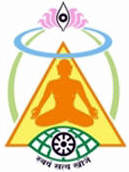
Mudra
For the successful practice of Preksha Meditation, the body must be still. Posture is, therefore, an important part of Preksha Meditation. Any posture that produces discomfort or distraction is not conducive for the practice. An advanced practitioner may stand and those who have particular infirmities may lie down or sit in chairs. But a sitting posture is most commonly adopted. There are four common sitting postures:
- Padmaasan (lotus position)
- Ardha-padmaasan (half-lotus position)
- Sukhaasan (simple cross-legged position)
- Vajraasan (diamond position)
In addition to the position of the body, the position of the hands, the mudra is also very important. During Preksha Meditation, one of the following two mudras can be applied:
- Gyan mudra Let the back side of your right hand rest on your right knee and the left hand on the left knee. Let the index finger of each hand touch and slightly press the tip of the thumbs at the point of the contact. The other fingers should be kept spread out and straight.
- Veetraag mudra
Turn both the arms inward at the elbows. First, keep the left palm in the center of your lap and then place the right palm on top of the left palm. Don t let your hands touch the ground. Avoid keeping your palms tilt downwards.
 Sadhvi Vishrut Vibha
Sadhvi Vishrut Vibha

